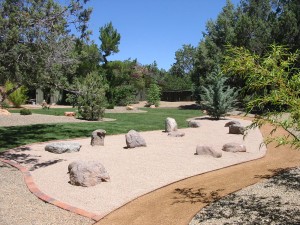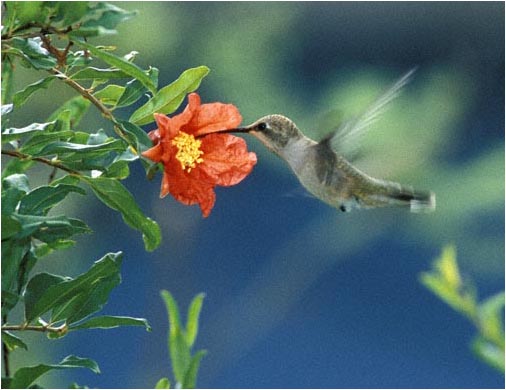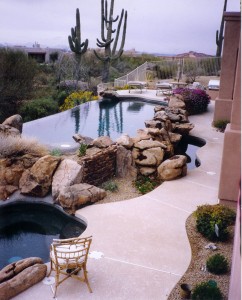The term water feature typically refers to an assembly of natural materials including boulders, stones and gravel to mimic a form of a stream or waterfall you would see in nature. Fountains are usually more formal style structures that create a jet or stream of water from a decorative piece or nozzle.
Natural water features use various types of stone and river rock. Here in Sedona, we have an abundance of what everyone calls “red rock”. It is a type of sedimentary rock formed by layers of ocean bed over millions of years. Sedimentary stone is not unique to Sedona, however the red color is due to the presence of iron oxide.
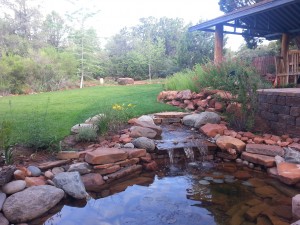 Since the local red boulders are so readily available as a local resource, they are relatively cheap compared to another kind of natural boulder found outside of the Sedona area and is a type of granite, which is heavier. Boulder types are named from the area where they are mined, such as Hasayampa Gold. Boulders that come from Sedona are simply called Sedona Red. Since everyone in Sedona loves the red rocks, using the red rock boulders of Sedona are the most popular choice for water features.
Since the local red boulders are so readily available as a local resource, they are relatively cheap compared to another kind of natural boulder found outside of the Sedona area and is a type of granite, which is heavier. Boulder types are named from the area where they are mined, such as Hasayampa Gold. Boulders that come from Sedona are simply called Sedona Red. Since everyone in Sedona loves the red rocks, using the red rock boulders of Sedona are the most popular choice for water features.
Another type of natural stone that is used in Sedona water features is called Moss rock which is typically a type of sedimentary stone that has surface growth of moss and lichens and is usually hand harvested since these boulders are located on the surface of the land. They are also weather eroded from water and wind giving them uniqueness quite different than the red rock.
The third type of rock used in Sedona water features is known as river rock and is commonly found in our streams, rivers and washes. It is smooth and rounded and comes is screened to produce sizes ranging from ½” pebbles to large boulders. River rock is typically used to line the underwater portions of the water features, especially along the stream courses and the basins. Since river rock does not stack very well nor does it look natural when stacked, it is always used under the water where it mimics its natural condition.
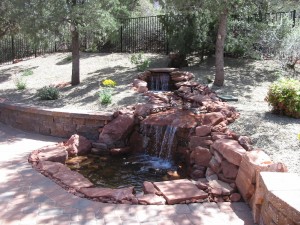
How Are Sedona Water Features Built?
Most water features are dug into the ground in which a rubber liner is placed to contain the water. The type of liner most used is called EPDM rubber and typically 45 mil thickness. The liner is placed on top of an underlayment fabric that helps prevent any damage to the liner from rocks, soil and roots, etc.
The plumbing components consist of a skimmer box inside of which the pump is placed. This works just like a swimming pool filter and has a weir that draws in the water at the surface level. Inside the skimmer box is also filtration screening materials that can be accessed for periodic maintenance.
The pump pushes the water up through a “return line” to the highest point of the water feature where either the simple end of the pipe discharges water or it can be plumbed to a “waterfall box” that has various widths of the lip opening for different effect on the face of the waterfall. The waterfall box can also be the location for a biological filter and contain media to help colonize good bacterial that keep the pond aspects in balance. A water feature that does not contain aquatic plants or fish does not need a biological filter.
Key Design Tips for Sedona Water Features
1) Natural. The whole point is that the water feature looks like it belongs where you are building it or at least integrating it the best you can in your man made landscape. Not everyone has a perfect slope of red rock formations ready to be used for a water feature.
2) Elevation change. Water flows downhill so naturally the end of the pump’s return line must be higher than the pump at the low point. The more the elevation difference, the more cascading drops and sheer drops you can create with the arrangement of stone.
3) Avoid artificial mounds. On a flat property, it is tempting to bring in a pile of dirt to create a mound so you can artificially create the necessary elevation drop. This is the number one mistake made by amateurs and the reason such water features tend to not look natural.
4) Use different size boulders. Depending on your access to heavy equipment to lift large boulders, varying the size of boulders is important rather than using uniform size stones.
5) Create pockets for plant material. Plant material close to the edge of the water feature in strategic locations using appropriate plants will enhance the natural appearance. Envision the kinds of shrubs you are going to place as you are creating the pockets.
Maintaining Your Sedona Water feature
For water features that contain no plants or fish, cleaning the filter screen in the skimmer box is required. Also make sure the automatic water leveler fill valve is operating properly and is not stuck which could lead to over flowing the basin. A well designed water feature will have a pipe situated a bit higher than the desired water level in case the basin is over topped due to a stuck valve or inordinate amount of rainwater.
If algae becomes a problem, there are products sold that will control the algae and clarify the water. Do not use chlorine or bleach as this can damage the pump components.
Winterizing Your Sedona Water feature
About half of winter nights in Sedona experience freezing temperatures. Two or three of these, on average, drop down into the range of 11 to 20 °F (-12 to -8 °C). Lows in the teens can occur from November to March, but are most likely in December.
Is it necessary to take certain measures to protect the pump for a water feature in Sedona? Most pump warranties I have seen recommend removing the pump during freezing temperatures and storing the pump in a bucket of water indoors. There is also the argument that leaving a pump running actually reduces the likelihood of the water freezing because flowing water does not allow water pressure to rise when flowing through pipes. Typically, the surface of the pond may freeze and ice develops on areas where the water flows, but inside the skimmer where the pump is at is not at risk as much as the surface areas.
It is recommended to shut off the water supply line that controls your auto fill valve during freezing temperatures. Keep an eye of the water level and fill with a hose if there is some loss due to evaporation.
